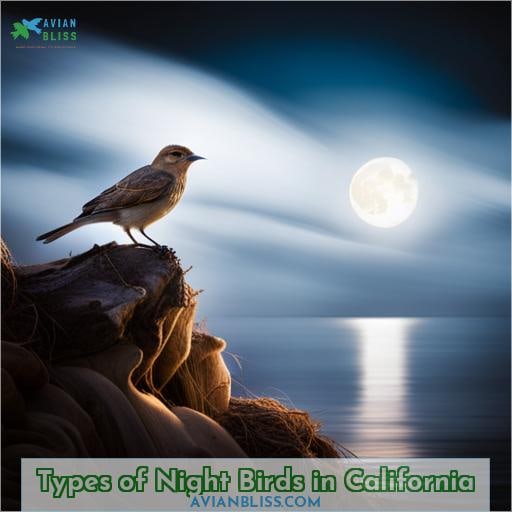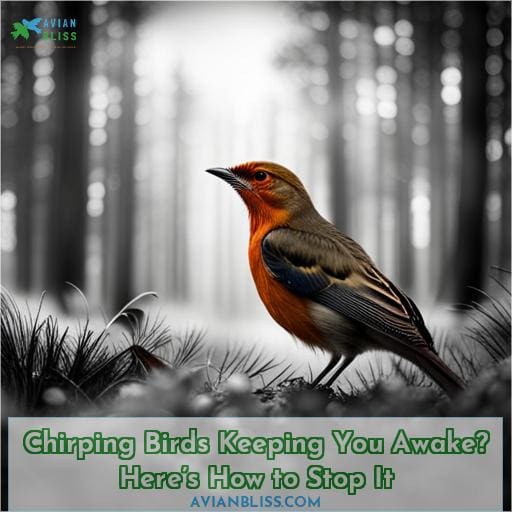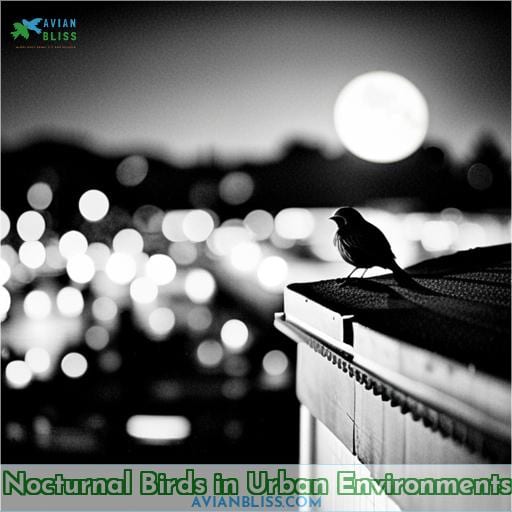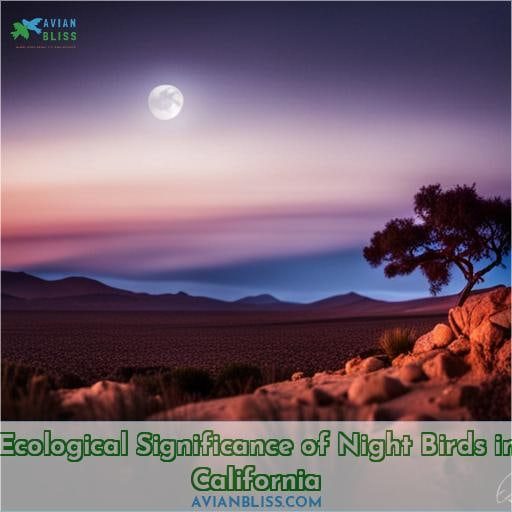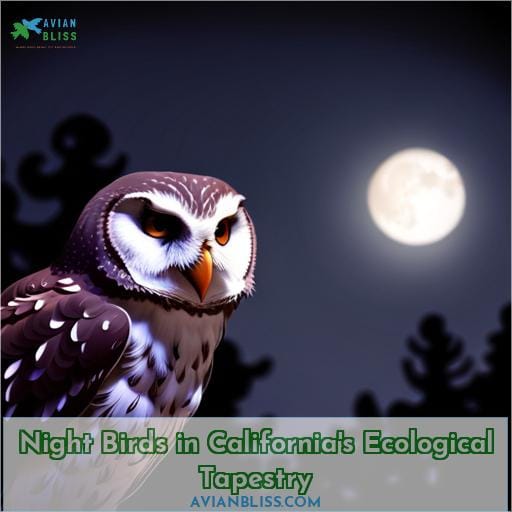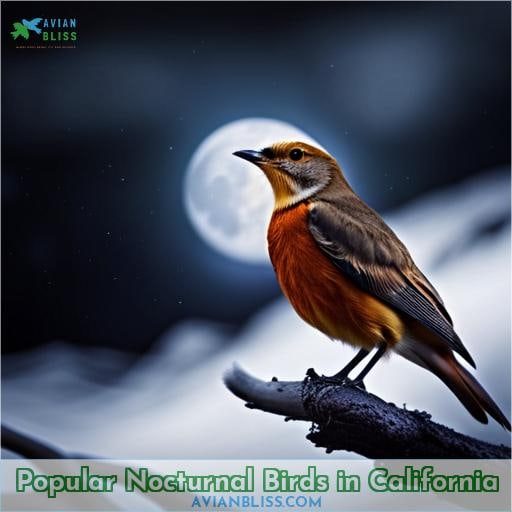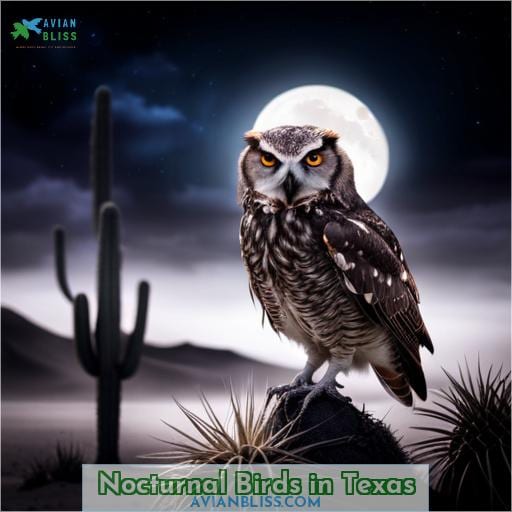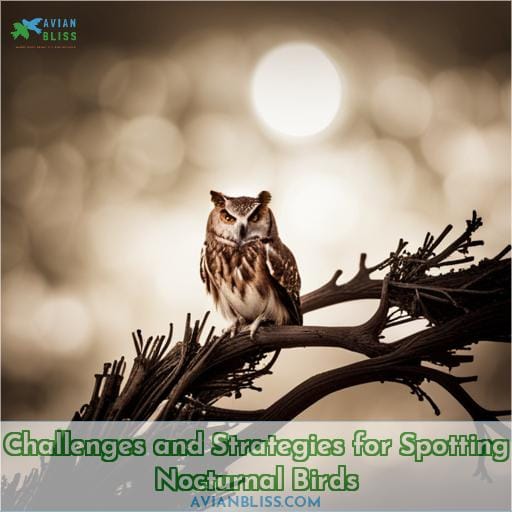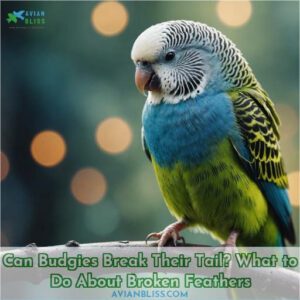This site is supported by our readers. We may earn a commission, at no cost to you, if you purchase through links.
 Greetings, fellow bird lover! The twilight hours beckon a symphony of avian voices as day-flyers settle in for the night and night-hunters emerge from slumber.
Greetings, fellow bird lover! The twilight hours beckon a symphony of avian voices as day-flyers settle in for the night and night-hunters emerge from slumber.
From whip-poor-wills to great horned owls, California’s landscapes come alive after sunset with the sights and sounds of its impressive night bird diversity. We embark on this evening’s excursion through scientific curiosity and a shared appreciation for the natural world.
Our feathered friends have much to teach about adaptation, ecology, and the delicate balance of ecosystems.
Join me now in discovering and identifying the most captivating night birds in California. This journey connects us not only to nature but also to that innate desire for wisdom and belonging that lives within us all.
The cool night air refreshes our perspectives and opens new possibilities as we train our sights and insights toward the avian treasures awaiting us.
Let’s begin!
Table Of Contents
- Key Takeaways
- Types of Night Birds in California
- Nocturnal Bird Sounds in California
- Birds That Sing at Night in California
- Chirping Birds Keeping You Awake? Here’s How to Stop It
- Nocturnal Birds in Urban Environments
- Ecological Significance of Night Birds in California
- Night Birds in California’s Ecological Tapestry
- Popular Nocturnal Birds in California
- Nocturnal Birds in Texas
- Challenges and Strategies for Spotting Nocturnal Birds
- Frequently Asked Questions (FAQs)
- How do nocturnal birds in California adapt to the challenges of urban environments?
- What are some popular species of nocturnal birds found specifically in California?
- How do chirping birds affect sleep, and what strategies can be employed to minimize their impact on sleep quality?
- What are the unique sounds produced by nocturnal birds in California, and how can bird enthusiasts learn to identify them?
- What are the key ecological roles that night birds play within California’s diverse ecosystems?
- Conclusion
Key Takeaways
- Nocturnal birds in California create enchanting twilight symphonies.
- Diverse species coexist, including night hunters like owls and day-flyers like mockingbirds.
- Habitat loss and urbanization threaten night bird populations.
- Specialized gear and knowledge are needed to understand their behavior.
Types of Night Birds in California
Greetings. Nature’s night shift features Northern Mockingbirds whistling and imitating calls, the odd nocturnal chirps of Yellow-breasted Chats, aerial Common and Lesser Nighthawks, the distinctive two-note song of Common Poorwills, and Black-crowned Night-Herons fishing after dusk.
You may also hear the hoots of Great Horned Owls, screeches of Barn Owls, and other night bird voices as California’s avian diversity comes alive when the sun goes down.
Northern Mockingbird
You’re walking along a moonlit trail when a melodic whistling catches your ear.
It’s the Northern Mockingbird, imitating sounds under the stars.
This vocal virtuoso learns songs on its own, even mimicking cell phones.
Rising habitat loss affects mockingbird nesting areas in bushes and trees.
During mating season, males fiercely defend territory with songs and displays.
With self-taught tunes, mockingbirds sing day and night.
Its creative concerts entertain yet sometimes annoy light sleepers.
Still, this iconic songster plays a valuable role.
As predators hunt, mockingbirds sound alarm calls.
While foraging on insects and berries, they disperse seeds.
Truly, the mockingbird’s remarkable repertoire reflects California’s diversity.
So listen a while under the moonlight to this avian composer’s symphony.
Yellow-breasted Chat
You’d be surprised to learn that the Yellow-breasted Chat migrates over 2,500 miles from its wintering grounds in Mexico to its breeding territory in California. This secretive and elusive songbird performs an animated mating dance and emits alluring nocturnal calls.
The beautifully patterned warbler evades predators like the great horned owl and barn owl while nesting.
Common Nighthawk
Let the Common Nighthawk soar across twilight skies as it migrates and exhibits dusk and dawn activity.
- Sing out as you soar.
- Glide on outstretched wings.
- Dive with reckless abandon.
- Dance through the dying light.
- Embrace the endless sky.
The Common Nighthawk is a remarkable nocturnal bird that brings wonder to all who observe its aerial grace.
Lesser Nighthawk
Having scoured scrublands and deserts, you’ve spied the smaller cousin to the common nighthawk, attracted like a moth to the flame of lights. This desert dweller, a tiny terror, unleashes its creepy cry under star-st� skies.
Despite its diminutive size, a fierce hunter emerges at dusk, chasing insects amidst dust devils. Though mockingbirds and owls reign supreme, this nimble acrobat of the night deftly navigates low light.
Common Poorwill
Hunting small insects attracted to the moonlight, you flee the desert floor and take wing under cover of darkness.
- Your mournful whoo whoo calls across the night.
- Wings thrashing to avoid deadly owls.
- Camouflage conceals nests on scrubby ground.
Previously aloft amidst westward migration, now grounded for nesting duties.
Mexican Whip-poor-will
You’d swear the Mexican whip-poor-will’s haunting song could lull an insomniac bear to sleep. This remarkable night bird nests in desert canyons. Its spirited calls echo through the darkness, enriching California’s night soundscape.
Black-crowned Night-Heron
At dusk, you’ll find the Black-crowned Night-Heron foraging for fish and frogs. It hunts stealthily in wetlands, adept at catching prey in dim light.
Great Horned Owl
You’ve perched high up in a tree, peering through the darkness as the great horned owl’s yellow eyes search below for prey.
- Talons for grabbing prey
- Excellent low-light vision
- Distinctive ear tufts
- Powerful beak for tearing flesh
- Can turn heads 270 degrees
Great horned owls thrive from Alaska to Patagonia. Their population is stable, and they adapt well to habitats from deserts to rainforests. Though territorial, they tolerate humans. Their deep hoots are a familiar nighttime refrain.
Barn Owl
With eyes like saucers, you spot the ghostly Barn Owl gliding over the moonlit field. Related to grass owls, its heart-shaped white face peers down. It soars on long wings, hunting rodents, its flight silent.
This owl nests and roosts in barns or caves, valued by farmers. But habitat loss threatens populations, so conservationists protect wetlands. Join local groups in restoring roosts and reduce noise pollution. Though still abundant, be vigilant in saving this raptor.
Long-eared Owl
Smaller than some other owls, the long-eared owl is often seen during the winter months as it preys on woodlands. Hunting rodents, its numbers decline with habitat loss. Focused conservation helps species like the western meadowlark.
Nocturnal Bird Sounds in California
The diverse repertoire of nocturnal bird calls in California provides an enchanting nighttime chorus. As darkness descends, you may hear the boisterous hooting of a Great Horned Owl or the gentle cooing of a Western Screech Owl.
The melodic trills of a Northern Mockingbird may echo across canyons, mimicking other species.
Seasonal migration brings Yellow-breasted Chats with their distinctive nocturnal singing. At dawn, you may hear the buzzy chirps of Black-crowned Night Herons as they return to roosts. The haunting cries of Common Nighthawks hunting on the wing contrast with the soft hoots of shy Long-eared Owls.
By listening closely after sunset, you can detect Burrowing Owls or Marsh Wrens. Even in urban areas, night birds find habitat, so don’t miss the chance to behold their diversity. With some preparation and the right equipment, like spotting scopes or audio recorders, the sounds of nocturnal birds in California will unveil a fascinating hidden world.
Birds That Sing at Night in California
Let’s tune into California’s nighttime chorus. Marsh wrens serenade the wetlands, killdeer peent across moonlit fields, and robins chuckle through the dark as you venture out to encounter the Western Meadowlark’s enchanting song carried on the wind.
Western Meadowlark
Navigate through this intricate tapestry of California’s ecosystems to grasp the profound role played by these enigmatic nocturnal creatures, uncovering their significance and contributions.
- Explore Meadowlark habitats under the starlit Californian skies.
- Delve into their intricate vocalization patterns, a symphony of the night.
- Learn about Meadowlark conservation efforts that safeguard both their habitats and the secrets they hold.
Marsh Wren
Intricately woven into the vibrant fabric of the nocturnal symphony, the Marsh Wren emerges as a minstrel of hidden marshlands, casting its enchanting melodies across the veil of darkness.
In the stillness of marshes, the Marsh Wren orchestrates its vocal prowess, melding diverse calls into a harmonious nocturnal tapestry. Their concealed nature, highlighted during the breeding season, underscores the need for robust conservation efforts.
Amidst the darkness, the Marsh Wren’s song remains an emblem of the delicate balance within nature’s nocturnal realm.
| Habitats | Vocalizations | Behavioral Patterns |
|---|---|---|
| Wetlands, marshes | Complex and varied | Agile and secretive |
Killdeer
As you venture into the enchanting realm of nocturnal nature, envision encountering the spirited essence of the Killdeer. This wily wanderer of shadows, famed for its echoing call across moonlit landscapes, holds secrets of its nocturnal habits, favored habitats, intricate breeding behaviors, evocative vocalizations, and its shrewd ways of eluding predators.
American Robin
Explore the vibrant essence of the American Robin as it gracefully weaves its melodious presence into California’s nocturnal symphony. Nighttime foraging unveils its adaptable behavior, seeking insects and fruits. Breeding habits align with the twilight, ensuring progeny survival.
Its vocalizations at night blend seamlessly, resonating through the ecological tapestry, affirming its vital role.
Chirping Birds Keeping You Awake? Here’s How to Stop It
Amidst the enchanting symphony of night birds gracing California’s twilight hours, the persistent chirping might occasionally pose a gentle challenge to your tranquil slumber. Fret not, for as you navigate this avian serenade, consider employing the subtle veils of curtains and blinds, the soothing hum of fans and white noise machines, the hush of earplugs and soundproofing – your allies in the nocturnal endeavor.
And remember, as nature’s chorus swells with the fervor of mating season, patience shall prove your steadfast companion, guiding you through this timeless nocturnal rite.
Curtains and Blinds
Now, let’s dive into a simple yet effective solution: draw those curtains or blinds and create your own peaceful oasis.
Blind Solutions: Opt for blackout blinds that shield your space from intrusive moonlight.
Sleep Disturbances: Curtail disruptions caused by nocturnal chirps, enjoying uninterrupted rest.
Window Coverings: Embrace decorative curtains that cocoon your room in tranquility.
Nighttime Privacy: Safeguard your sanctum from prying eyes while relishing the night symphony.
Decorative Curtains: Merge aesthetics with functionality by selecting curtains that complement your style and quieten the avian serenades.
Fans and White Noise Machines
Immerse yourself in the soothing ambiance created by fans and white noise machines, offering a respite from the persistent serenades of nocturnal songsters. As night birds’ adaptations meet urban birdlife, their nocturnal behavior may disrupt your sleep.
These solutions grant a semblance of control over sleep disturbance, illuminating the ecological nighttime roles these birds perform.
Earplugs and Soundproofing
Block out the disruptive symphony of sounds with snug-fitting earplugs and the comforting embrace of soundproofing solutions, allowing you to reclaim your tranquil sanctuary.
Experience a profound shift in your nightscape:
- Embrace the cocoon of silence, fostering introspection.
- Unveil the understated elegance of nocturnal life.
- Awaken to the symphony of your dreams, undisturbed by nocturnal choruses.
Rediscover the potent harmony of nature and nurture, as effective earplugs and soundproofing methods shield you from the discordance of sleep disturbance.
Patience During Mating Season
Embrace a touch of patience as the enchanting melodies of nature’s harmonizers fill the moonlit air, creating a symphony that accompanies the vibrant dance of life.
Night bird behaviors unfold with mesmerizing intricacy, from migratory patterns that span continents to courtship rituals illuminated under star-st� canopies.
Nocturnal communication becomes an artistry of calls and songs, weaving tales of connection through the velvety darkness.
As shadows deepen, these creatures venture into the realm of nighttime foraging, where their finely honed senses guide them through the obsidian landscape.
Each pause between their rhythmic melodies holds the promise of courtship and continuity, an ancestral script written across the nocturnal canvas.
Nocturnal Birds in Urban Environments
Nestled within the luminous expanse of Los Angeles, a captivating phenomenon unfolds with the nocturnal avian denizens. As urbanization weaves its path, a symphony of adaptation and resilience emerges among these night birds, orchestrating an extraordinary tale of survival and harmony amidst the city’s bustling lights.
Adaptation to Urban Settings
Navigate through the intricate urban landscape and observe how these remarkable creatures adeptly adjust to their surroundings, showcasing their ability to harmonize with the city’s rhythm. Urban adaptation is a ballet of survival, where nocturnal behavior intertwines with the pulse of city birdlife.
Nighttime ecology reveals their strategic ventures, as they navigate neon-lit streets and verdant oases. Amidst the urban bustle, these denizens of the night find refuge and sustenance, weaving their presence into the tapestry of human existence.
Urban wildlife interaction takes on new dimensions, as the mysterious allure of nocturnal birds evokes a profound connection with the nocturnal soul.
Birds in Los Angeles
Glide through the urban expanse of Los Angeles, where these remarkable creatures harmoniously adapt to city life, showcasing their resilience amidst the bustling metropolis. Witness their nocturnal behavior, a dance of adaptation to the bright lights and cacophony of the city that never sleeps.
As night falls, the Los Angeles avifauna comes alive with its own symphony. Explore the secrets of their urban adaptation:
-
Camouflaged Plumage: Nocturnal birds cloak themselves in cryptic plumage, a blend of grays and browns, allowing them to blend seamlessly with the shadows of concrete and foliage.
-
Echo-location Mastery: Some, like the Western Screech Owl, harness the power of echolocation, navigating through the urban labyrinth with precision, finding hidden prey and safe perches.
-
Diet Diversification: Urban environments necessitate dietary flexibility. From foraging rodents to feasting on insects drawn to streetlights, night birds exploit the bounty of the city’s resources.
-
Nesting Nooks: Adapted nesting habits reveal the craftiness of urban survival. Birds ingeniously nest atop ledges, within abandoned structures, and even repurposed signs, carving out homes amid the man-made landscape.
As the city buzzes with activity, these avian denizens remind us of nature’s persistence amidst the concrete jungle. Their existence speaks to the delicate balance between progress and preservation, inviting us to embrace night bird conservation for the harmony of urban ecology.
Ecological Significance of Night Birds in California
In the intricate tapestry of California’s diverse ecosystems, the night comes alive with the enchanting calls of whippoorwills, the graceful flights of nighthawks, and the stealthy hunts of owls. As these nocturnal emissaries take to the skies, their role in the delicate balance of nature unfolds, weaving a story of predation, pollination, and population control that underscores their indispensable significance within these habitats.
Whippoorwills, Nighthawks, and Owls
As you delve deeper into the realm of the darkened skies, an enchanting symphony unfolds, resonating with the haunting calls of whippoorwills, the fleeting dance of nighthawks, and the silent prowess of owls.
These creatures are emissaries of the night, embodying the intricate tapestry of nature’s adaptations.
Nocturnal behavior patterns are their artistry, finely tuned to the rhythms of darkness. Their cryptic plumage and keen senses enable them to navigate obscurity with grace. Vocalizations of owls, a primordial language, echo through the night, carving their place in the hidden conversations of the wild.
Yet, amidst this mystique, a somber reality beckons – night bird conservation. Urbanization’s encroachment threatens their habitats, prompting us to illuminate their importance. In this chiaroscuro realm, they master nocturnal hunting strategies, embracing their roles as both predator and sentinel, ensuring the equilibrium of nocturnal ecosystems.
Role in Ecosystems
Picture yourself in the midst of diverse habitats, where these enigmatic creatures weave into the tapestry of life, contributing intricately to the balance of nature. Nocturnal behaviors of California’s night birds reveal a symphony of ecological interactions.
They dance within the shadows, engaging in a delicate balance of predation dynamics, preying on smaller creatures while also becoming the prey themselves. Their reproductive strategies are finely tuned to the moonlit rhythms, ensuring survival through generations.
Conservation efforts play a crucial role as urbanization encroaches. These birds, symbols of liberation, hold the power to deepen our understanding of the night’s mysteries and our role within them.
Night Birds in California’s Ecological Tapestry
Immerse yourself in the intricate tapestry of California’s diverse ecosystems by discovering the indispensable role these nocturnal creatures play within the realm of darkness.
As the sun sets and diurnal species retreat, night birds emerge to shape the nocturnal landscape. Nocturnal behaviors are finely tuned adaptations to the cover of night, allowing these avian denizens to thrive in a world illuminated by the moon’s soft glow.
Ecosystem interactions weave a delicate dance of predator and prey. Owls, with their keen senses and stealthy flight, exert a crucial influence on rodent populations, maintaining ecological balance. Nighttime adaptations are remarkable feats of evolution; the soft plumage of owls enables near-silent flight, granting them the element of surprise in their nocturnal hunts.
Conservation efforts resonate in the dark hours, as habitats face challenges from urbanization and habitat fragmentation. Preserving nocturnal habitats ensures the survival of species like the Western Screech-Owl, a testament to nature’s resilience amid change.
California’s nocturnal symphony is a testimony to the power of understanding and liberation in the realm of the unseen. As you explore this enigmatic world, remember that beneath the shroud of night, a dynamic ecosystem thrives, reminding us of the interconnectedness of all life forms.
Popular Nocturnal Birds in California
Delve into the captivating realm of California’s nocturnal avifauna as we unveil the enigmatic world of the Western Screech Owl and the majestic presence of the Great Gray Owl. These remarkable night birds, each adorned with their distinct attributes, epitomize the intricacies of nature’s design while enriching the tapestry of California’s diverse ecosystems.
Western Screech Owl
Imagine yourself in the serene landscape of the West Coast, where the veil of darkness brings forth a symphony of nature’s hidden musicians. In this quiet realm, the Western Screech Owl emerges as a skillful performer, adapting seamlessly to urban realms, its call echoing through the night like a whispered secret carried on the wind.
These nocturnal birds are masters of adaptation, concealing themselves in plain sight with feather camouflage that blends effortlessly into tree bark. Their vocalizations, a series of trills and haunting whinnies, create an ethereal ambiance in the night.
Unlike some owls, they thrive in urban environments, utilizing nest boxes and cavities in trees, showing remarkable resilience in the face of urbanization.
So, as you stand under the starlit California sky, listen closely to the Western Screech Owl’s melodic whispers, a testament to nature’s ability to thrive even in the heart of the city.
Great Grey Owl
As you venture into the realm of these fascinating creatures, the Great Grey Owl stands out as a master of silent nocturnal hunting. Its large facial disc and keen hearing allow it to pinpoint prey with remarkable precision.
This magnificent owl, a true embodiment of nature’s nocturnal prowess, exhibits captivating behavior that leaves a lasting impression on those fortunate enough to witness it.
Capturing the essence of this majestic species through night bird photography can be both exhilarating and challenging, requiring patience and a deep understanding of their elusive habitat preferences.
Conservation efforts aimed at protecting the Great Grey Owl’s habitat reflect our shared commitment to preserving the delicate balance of our ecosystems.
To enhance your nocturnal birdwatching experience, consider these tips: find a suitable location, employ soft and muted lighting, and maintain a respectful distance. In the enigmatic presence of the Great Grey Owl, you’ll find a source of liberation, power, and understanding that only the natural world can offer.
Nocturnal Birds in Texas
Explore the vibrant Texan nocturnal scene, where the captivating symphony of wildlife comes alive under the starlit sky. Immerse yourself in the enchanting world of night birds as they unveil their mysteries amidst the darkness.
Delve into the diverse owl species diversity, a testament to the Lone Star State’s thriving ecosystem. Marvel at the impressive array of heron nocturnal behaviors, witnessing their graceful foraging for fish and frogs in the moon’s shimmering glow.
Gaze in awe at the hawks in Texas, soaring through the night with unwavering precision, their keen eyesight guiding them to hidden prey below. Observe the mesmerizing phenomenon of night bird migration, a breathtaking journey undertaken by countless species as they navigate by instinct and celestial navigation.
Amidst the tranquil night, let the symphony of owl vocalizations serenade you. From the haunting hoots of the Great Horned Owl to the eerie screeches of the Barn Owl, their calls paint a vivid auditory tapestry in the dark.
Engage in this nocturnal spectacle, a glimpse into the lives of creatures that thrive in the enigmatic realm of the night.
Challenges and Strategies for Spotting Nocturnal Birds
Embarking on the endeavor of observing nocturnal avian denizens in California’s diverse habitats requires the right gear and equipment, serving as extensions of your senses under the shroud of darkness.
Equipped with night vision optics, acoustic recorders, and flashlight filters that preserve night-adapted vision, you are poised to decode the enigmatic lives of these creatures. Alongside your equipment, adept guidance and thorough research into the behavior and habitats of these elusive night birds will illuminate their nocturnal world, revealing the intricacies of their adaptations and unveiling the symphony of their hidden activities.
Gear and Equipment
Equip yourself with specialized gear like high-quality binoculars, sensitive microphones, and infrared cameras to delve into the captivating world of these fascinating creatures of the dark. Night vision becomes your ally, revealing hidden nocturnal behaviors. Master observation techniques that blend patience and precision; the art of silence is your tool.
Photography tips come in handy, utilizing low-light settings and minimizing disturbances. Select appropriate lighting options – subtle illumination ensures minimal disruption. Recording calls enriches your understanding of their vocal symphony. In this realm of obsidian hues, your gear is more than equipment; it’s the key to unlocking the mysteries that unfold under the cover of night.
Guides and Research
To enhance your understanding and maximize your success in observing these fascinating creatures during the dark hours, consider relying on valuable guides and conducting thorough research. This will provide you with the knowledge needed to locate and appreciate these elusive inhabitants of the night.
-
Night Bird Behavior: Delve into the intricate behaviors of nocturnal birds, such as their foraging strategies, territorial calls, and courtship rituals. Understanding these behaviors will assist you in predicting their movements and identifying potential observation sites.
-
Research Methods: Engage in studies that focus on night bird ecology, including their preferred habitats, nesting sites, and interactions with other species. This research foundation will guide your fieldwork and contribute to a deeper appreciation of their role in the ecosystem.
-
Nocturnal Adaptations: Immerse yourself in the realm of nocturnal adaptations, from specialized feathers for silent flight to keen nocturnal vision. This knowledge will unveil the remarkable ways these birds have evolved to thrive under the cover of darkness.
-
Bird Migration Patterns: Explore the migratory patterns of night birds, unraveling the mysteries of their journeys across different landscapes. Understanding their seasonal movements will aid in anticipating their presence in specific regions during different times of the year.
-
Nocturnal Bird Vocalizations: Familiarize yourself with the diverse array of night bird calls and songs. Learning to distinguish between species by their vocalizations will elevate your birdwatching experience, allowing you to identify them even in the absence of visual cues.
By immersing yourself in these aspects of nocturnal bird observation, you embark on a journey of liberation and empowerment, armed with the knowledge to decipher the enigmatic world of night birds.
Frequently Asked Questions (FAQs)
How do nocturnal birds in California adapt to the challenges of urban environments?
Amidst California’s urban sprawl, nocturnal avian denizens persist, adapting ingeniously. Notably, the Western Screech-Owl, with urban resilience, thrives—its diet is versatile and intriguingly, it is a commendable insect predator, consuming hundreds nightly.
What are some popular species of nocturnal birds found specifically in California?
Ever wondered about the enigmatic creatures that grace California’s moonlit tapestry? Delve into the intriguing lives of nocturnal birds – from the melodious Mockingbird to the vigilant Great Horned Owl.
How do chirping birds affect sleep, and what strategies can be employed to minimize their impact on sleep quality?
To safeguard tranquil slumber amidst nocturnal choruses, employ strategies for harmonious coexistence. Shield your sanctuary with layered curtains, soft fans, and soothing earplugs. The symphony of nature need not disrupt your realm of dreams.
What are the unique sounds produced by nocturnal birds in California, and how can bird enthusiasts learn to identify them?
Discover the captivating symphony of California’s nocturnal birds. Immerse yourself in the enchanting calls of nighthawks, the haunting hoots of owls, and the melodic songs of night singers.
What are the key ecological roles that night birds play within California’s diverse ecosystems?
Delve into California’s night symphony: Night birds are ecological maestros, orchestrating balance. Owls command the nocturnal realm, their prowess weaves an intricate tapestry, whispering nature’s secrets under the moonlit cloak.
Conclusion
Amidst the dusky symphony of California’s varied habitats, night birds emerge as the elusive minstrels of the night, weaving their melodies through the tapestry of darkness. From the moonlit imitations of the Northern Mockingbird to the haunting calls of the Great Horned Owl, these avian denizens embody the enigma of the nocturnal realm.
As urban sprawl intertwines with natural realms, the likes of Barn Owls and Western Screech-Owls showcase remarkable adaptability, gracing both cityscapes and woodlands. Within the intricate ecosystem, these creatures bear significance beyond song, orchestrating the balance as skilled predators and pivotal links.
While curtains and patience veil the nocturnal serenades, each note resonates with the heartbeat of California’s wilderness, echoing the steadfast presence of night birds in California’s ecological mosaic.

